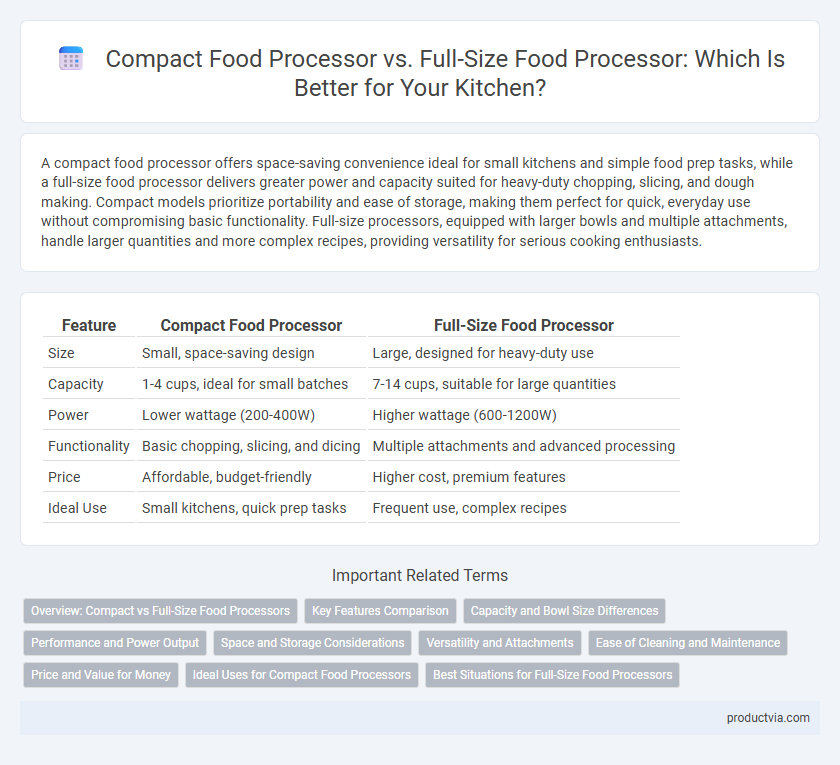A compact food processor offers space-saving convenience ideal for small kitchens and simple food prep tasks, while a full-size food processor delivers greater power and capacity suited for heavy-duty chopping, slicing, and dough making. Compact models prioritize portability and ease of storage, making them perfect for quick, everyday use without compromising basic functionality. Full-size processors, equipped with larger bowls and multiple attachments, handle larger quantities and more complex recipes, providing versatility for serious cooking enthusiasts.
Table of Comparison
| Feature | Compact Food Processor | Full-Size Food Processor |
|---|---|---|
| Size | Small, space-saving design | Large, designed for heavy-duty use |
| Capacity | 1-4 cups, ideal for small batches | 7-14 cups, suitable for large quantities |
| Power | Lower wattage (200-400W) | Higher wattage (600-1200W) |
| Functionality | Basic chopping, slicing, and dicing | Multiple attachments and advanced processing |
| Price | Affordable, budget-friendly | Higher cost, premium features |
| Ideal Use | Small kitchens, quick prep tasks | Frequent use, complex recipes |
Overview: Compact vs Full-Size Food Processors
Compact food processors typically feature a bowl capacity of 3 to 7 cups, making them ideal for small kitchens and light-duty tasks such as chopping, slicing, and pureeing. Full-size food processors offer larger capacities, often 10 cups or more, suitable for heavy-duty processing like kneading dough, shredding large quantities, and handling multiple ingredients simultaneously. Choosing between compact and full-size models depends on kitchen space, typical food preparation volume, and the need for versatility in processing functions.
Key Features Comparison
Compact food processors typically offer a smaller capacity, usually around 3 to 5 cups, making them ideal for quick tasks and limited counter space, while full-size models range from 10 to 14 cups, suitable for large batch processing and versatile kitchen use. Compact versions often feature fewer speed settings and basic attachments focused on chopping and slicing, whereas full-size processors include multiple blades, dough blades, shredding discs, and various speed controls for more complex culinary tasks. The power range also differs, with compact models generally operating between 300 to 600 watts, contrasting with full-size processors that deliver 600 to 1200 watts, enabling more robust performance for tougher ingredients.
Capacity and Bowl Size Differences
Compact food processors typically feature bowl sizes ranging from 3 to 7 cups, ideal for small batch food preparation and limited kitchen space. Full-size food processors offer larger capacities, generally between 9 to 14 cups, suitable for handling bigger volumes and more complex recipes. Bowl size directly impacts the maximum quantity of ingredients processed, influencing efficiency and versatility in meal preparation.
Performance and Power Output
Compact food processors typically feature motors ranging from 200 to 500 watts, making them suitable for light tasks such as chopping vegetables and blending smoothies. Full-size food processors often have more powerful motors between 600 and 1200 watts, enabling them to handle heavy-duty tasks like kneading dough and processing large quantities of food efficiently. The higher power output in full-size models results in faster performance, smoother consistency, and greater versatility for complex recipes.
Space and Storage Considerations
Compact food processors offer a smaller footprint ideal for kitchens with limited counter space and easier storage in tight cabinets or drawers. Full-size food processors, while larger and bulkier, provide greater capacity and versatility but require dedicated storage areas due to their size. Choosing between the two depends on balancing available kitchen space with the need for processing volume and multi-functionality.
Versatility and Attachments
Compact food processors offer portability and convenience with essential attachments like chopping blades and dough hooks, ideal for small-scale tasks and quick food prep. Full-size food processors provide extensive versatility through multiple attachments such as shredding discs, slicing blades, and adjustable dough blades, supporting more complex culinary needs and larger batch processing. The choice depends on kitchen space, cooking frequency, and the variety of food preparation techniques desired.
Ease of Cleaning and Maintenance
Compact food processors offer ease of cleaning and maintenance due to fewer parts and smaller components, making them ideal for quick, everyday tasks. Full-size food processors, while more powerful, often have multiple attachments and larger bowls that require extra effort and time for thorough cleaning. Choosing a compact model simplifies upkeep, especially for users prioritizing convenience and minimal storage space.
Price and Value for Money
Compact food processors typically cost between $40 and $100, offering efficient performance for small to medium tasks, making them ideal for budget-conscious buyers seeking value without sacrificing essential features. Full-size food processors range from $100 to $300 or more, providing greater capacity, power, and versatility suitable for frequent use and large-volume food preparation, delivering better long-term value for serious cooks. Choosing between the two depends on balancing initial price against functionality and frequency of use to maximize cost-effectiveness and user satisfaction.
Ideal Uses for Compact Food Processors
Compact food processors excel in preparing small to medium quantities of ingredients, making them perfect for quick meal prep, chopping vegetables, and blending sauces. Their smaller footprint and efficient design provide convenience for limited kitchen spaces and single-serving recipes. Ideal for daily tasks like making pesto, salsa, or small batches of dough, compact models deliver versatility without sacrificing performance.
Best Situations for Full-Size Food Processors
Full-size food processors excel in handling large quantities of ingredients, making them ideal for batch cooking and meal prepping. Their powerful motors and larger bowls allow for efficient chopping, slicing, and pureeing of tough or dense foods like nuts, dough, and root vegetables. These processors suit households with frequent cooking demands or those preparing complex recipes that require versatility and speed.
Compact food processor vs Full-size food processor Infographic

 productvia.com
productvia.com